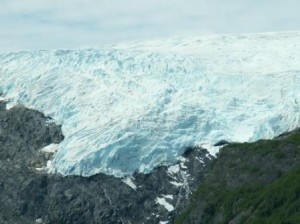Exit Glacier is the only part of Kenai Fjords National Park accessible by road. At Exit Glacier you can stroll the trails, walk very close to an active glacier, or take a ranger-led walk. 
To get to Exit Glacier, from Hotel Seward, head north out of town, turn onto the Herman Leirer/Exit Glacier Road at mile 3 of the Seward Highway. The 8.6 mile road to the Exit Glacier Area is paved, making it easily accessible to all types of vehicles. Taxi/shuttle service is available from Seward.
Like Hotel Seward Exit Glacier is open year-round. Upon the arrival of snow, usually in mid-November, the road is closed to cars but open to a wide-range of winter recreation – from snow machines to dogsleds and cross-country skiers. The road often remains closed through early May so be sure to check with the front desk at Hotel Seward for current conditions if you are visiting during the shoulder seasons (spring or fall).
There is a well maintained trail to the Edge of the Glacier. This moderately strenuous trail brings you near a wall of blue ice providing the most dramatic close up view of Exit Glacier.
If you are looking for a longer day hike, don’t miss the Harding Icefield Trail. A map of all the trails in the Exit Glacier area is posted near the Nature Center.
The Exit Glacier Nature Center includes hands-on exhibits and an Alaska Geographic book store. Flush toilets, near the Nature Center, are operable from Memorial Day through Labor Day. The rest of the year pit toilets are available. Exit Glacier has a 12-site, walk-in campground.
A glacier is a perennial mass of ice which moves over land. A glacier forms in locations where the mass accumulation of snow and ice exceeds ablation over many years.
Glacier ice is the largest reservoir of fresh water on Earth, and is second only to oceans as the largest reservoir of total water.
Glaciers cover vast areas of the polar regions and are found in mountain ranges of every continent, (there are glaciers in New Zealand). In the tropics glaciers are restricted to the highest mountains.
The distinctive blue tint of glacial ice is often wrongly attributed to Rayleigh scattering due to bubbles in the ice. The blue color is actually created for the same reason that water is blue, that is, its slight absorption of red light.
Share On: